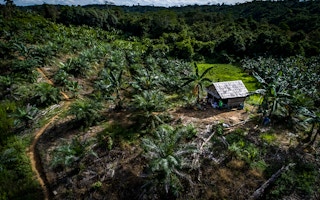In 2021, Asean contributed to a significant chunk of the world’s biofuel supply, with Indonesia producing 137,000 barrels per day of biodiesel, exceeding the United States and Germany. Other than being an export commodity, biofuel is needed by other major producers like Malaysia, the Philippines and Thailand to support their domestic energy demand and economic growth.
To continue reading, subscribe to Eco‑Business.
There's something for everyone. We offer a range of subscription plans.
- Access our stories and receive our Insights Weekly newsletter with the free EB Member plan.
- Unlock unlimited access to our content and archive with EB Circle.
- Publish your content with EB Premium.
Asean member states have also recognised biofuel’s potential to decarbonise energy systems. To date, five countries have enacted blending mandates – Indonesia with B40 (40 per cent palm-based biodiesel content) by 2030 and E50 (50 per cent ethanol content) by 2050, Malaysia with B20 and E10, Thailand with B20 and E85 and with a target to reach 20 to 25 per cent biofuel share in total energy demand by 2037, the Philippines with B10 by 2040 and E20 by 2040, and Vietnam with B10 and E10 to achieve 25 per cent share in transport sector’s fuel demand by 2050.
Nonetheless, with the rising attention to electric vehicle (EV) development, many question the merits of switching to biofuel over pushing for EVs, considering factors such as affordability, sustainability and supply chain readiness. However, pursuing both biofuel and EV might be the most practical option for Asean, if it is to curb emissions quickly in a way that cost the least.
Asean’s abundant biomass resource means there is the possibility of it developing a stable biofuel feedstock supply. Blending biofuels with commonly used transportation fuels such as gasoline and diesel also provides an alternative. On the other hand, Asean is also home to significant nickel reserves. With improved capacities in battery manufacturing, EV production can also gain fast momentum for the vehicles to reach price parity.
Nevertheless, increasing feedstock production is an obvious and crucial step for Asean so as to accomodate the growing biofuel market. The 7th ASEAN Energy Outlook (AEO7) notes that biofuel consumption will grow at 4.7 per cent per year until 2050, faster than that of oil at 4.4 per cent, reflecting the enhanced efforts to phase out the usage of fossil fuel-powered vehicles. Meanwhile, in 2022, Indonesia produced only 61.8 per cent of its nameplate capacity, equivalent to 10.3 billion litres of biodiesel from 9.5 million tonnes of crude palm oil (CPO). Comparing Indonesia’s biofuel production with its fossil fuel (gasoline) production, we can see stark differences: in 2022, biofuel production merely makes up 8.3 per cent of the total gasoline production.
Finding the solutions to feedstock availability is not only about increasing the production capacity of well-established agricultural commodities (e.g. CPO). Asean should consider diversifying its feedstock from biodiesel-oriented ones to ethanol because most passenger cars use gasoline, while diesel is mainly for heavy-duty vehicles. In 2022, Indonesia’s ethanol production was at a mere 40 thousand litres , much lower than the 10.1 billion litres of biodiesel produced in the same year. Malaysia has no ethanol programme.
Learning from global experience, the competing use of feedstock for food and energy fuel has driven up biofuel prices. Biodiesel has seen its prices rose 20 to 30 per centglobally in 2022. Bioethanol prices were up 20 per cent in Brazil and 30 per cent in the United States. CPO, the primary biodiesel feedstock in Indonesia and Malaysia, reached a record-high price of USD 1,800 per tonne in March 2022. Although it is predicted that the CPO price will stay around US$900 per tonne in 2023, we might expect a price spike if another unexpected global event happens, such as a reduction of grain exports from Ukraine due to the geopolitical conflict that started last year. Exploring non-food plants and waste biomass could help Asean venture into sustainable biofuel production.
Unfortunately, Asean’s biofuel industry is still largely dependent on crops. Coconut oil is the backbone of the Philippines’ biodiesel production, while Indonesia, Malaysia, and Thailand is reliant on palm oil. Molasses, a sugarcane or sugar beets derivative, is the primary ethanol feedstock in the Philippines and Thailand. On a much smaller scale, only Singapore has used waste, such as used cooking oil and animal fats (imported from Indonesia and Malaysia), to power vessels, including Formula One race cars. Cambodia had 1,000 hectares of jatropha plantation in 2018 for biofuel development although there are no updates on any production output.
In addition to non-food feedstocks, advanced biofuels such as hydrotreated vegetable oil (HVO) and biomass-to-liquid (BtL)-diesel and renewable diesel, could amplify Asean’s biofuel strength. Advanced biofuels are liquid fuels generally derived from non-food-based feedstocks and yield a lifecycle reduction in GHG emissions of at least 50 per cent compared with fossil fuels. Only a few Asean nations, including Indonesia, Malaysia, the Philippines and Thailand, have started research and development on advanced biofuels.
Indonesia has experimented with the B40 from 30 per cent Fatty Acid Methyl Ester (FAME) and 10 per centRefined, Bleached, and Deodorised Palm Oil (RBDPO) on 12 most popular passenger cars and commercial vehicles over 50, 000 km and 40,000 km respectively in July 2022. In its Alternative Energy Development Plan (AEDP) 2018, Thailand has set a target for 194 million litres pyrolysis oil (bio-oil) to be produced per year by 2037. When mixed with ethanol, pyrolysis oil can become a fuel for combustion engine vehicles.
Learning from the US, fiscal incentives might accelerate feedstock-switching from mainstream options to advanced ones, significantly benefiting the local community. Its Biomass Crop Assistance Program (BCAP) grants money to landowners and business owners who set up, grow, and distribute biomass plantations for advanced biofuel production. A 50-per-cent reimbursement of the cost of establishing a biomass feedstock crop is available to qualified feedstock producers, in addition to annual payments for up to five years for herbaceous feedstocks and up to 15 years for woody feedstocks.
Noting Asean’s rich agriculture resources, biofuel’s role would be vital for member countries’ net-zero plans. Solving the feedstock crunch is necessary to meet market demands, which requires careful policy and supply chain strategy. And elevating planning to regional cooperation might accelerate the countries’ progress in a more sustainable and less costly manner. Under the ASEAN Plan of Action for Energy Cooperation (APAEC) Phase II: 2021-2025, the ASEAN Biofuel Research and Development (R&D) Roadmap was introduced to resolve the existing barriers in upstream, midstream, and downstream elements through a coordinated approach within the member countries. The question now is how this roadmap could come to fruition in coming years.













